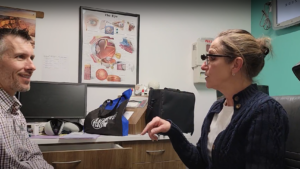Promoting INDEPENDENCE for Low Vision Patients.
Independence is at the heart of what I do for patients as a low vision provider. So with no more introduction needed, let’s jump right in to the Top 10 Ways to Promote Independence for Low Vision Patients!
#1) Leverage Technology: Smartphones and tablets come with built-in accessibility features such as text-to-speech, large fonts, high contrast modes, and voice commands. Additionally, many specialized apps can further aid in tasks like reading, identifying objects, or navigating. Search “best apps for low vision”
#2) Use Assistive Devices: There are many non-optical, non-prescription assistive devices available, such as talking clocks, large-print keyboards, and color identifiers. For a wide selection of aids, I like Maxi-aids, LS&S, and Independent Living Aids. They were able to make conversions from catalogs (when I started practicing) to successful online stores.
#3) Modify Home Environment: Make simple modifications at home like using high-contrast colors for critical items, improving lighting in commonly used areas (see this recent newsletter covering lighting), and organizing and labeling items in a consistent manner.
#4) Embrace Vision Rehabilitation Services: Low vision doctors (like myself), occupational therapists, orientation and mobility specialists, and other therapists can provide prescription and non-prescription glasses, aids, and training to help manage daily activities and navigate both familiar and new environments.
#5) Stay Active: Regular physical activity can enhance overall well-being and help maintain independence through fitness. Consider activities that are safe and enjoyable, such as walking, swimming, or guided exercise programs. Also, inactivity can amplify many disease states, including those in the eyes — so stay active!
#6) Learn New Skills: Skills such as touch typing, using a long cane, or learning Braille can help maintain independence and open up new opportunities for work and leisure. Also, patients committed to life-long learning can adapt more easily when unintended changes in health and vision occur.
#7) Maintain Social Connections: Staying socially active is crucial for emotional well-being. Joining a support group or participating in community activities can provide companionship and practical advice from others who are facing similar challenges.
#8) Use Public Transportation Services: Many cities, and even rural areas, offer special transportation services for people with disabilities. These services can provide door-to-door transport and help maintain independence and social connections (see #7 above).
#9) Prioritize Mental Health: Dealing with vision loss can be challenging. Consider seeking support from a mental health professional if feelings of sadness, frustration, or anxiety become overwhelming. Practicing mindfulness and relaxation techniques can also be beneficial. Again, maintaining social connections can be helpful in this area as well.
#10) Stay Informed and Advocated: Stay updated about new technologies, treatments, and resources. Advocacy is also important – know your rights, communicate your needs clearly, and don’t be afraid to ask for the accommodations you require to maintain your independence. Don’t allow your vision disability to limit your opportunities!

That last tip, advocacy…whether it’s driving, taxes, accessibility, or simply being on a level playing field, we always help advocate for your/our patients to the extent allowable by law.
For more information call 1-877-577-2040 to discuss your situation with us. Thank you, Dr. Jarrod Long
